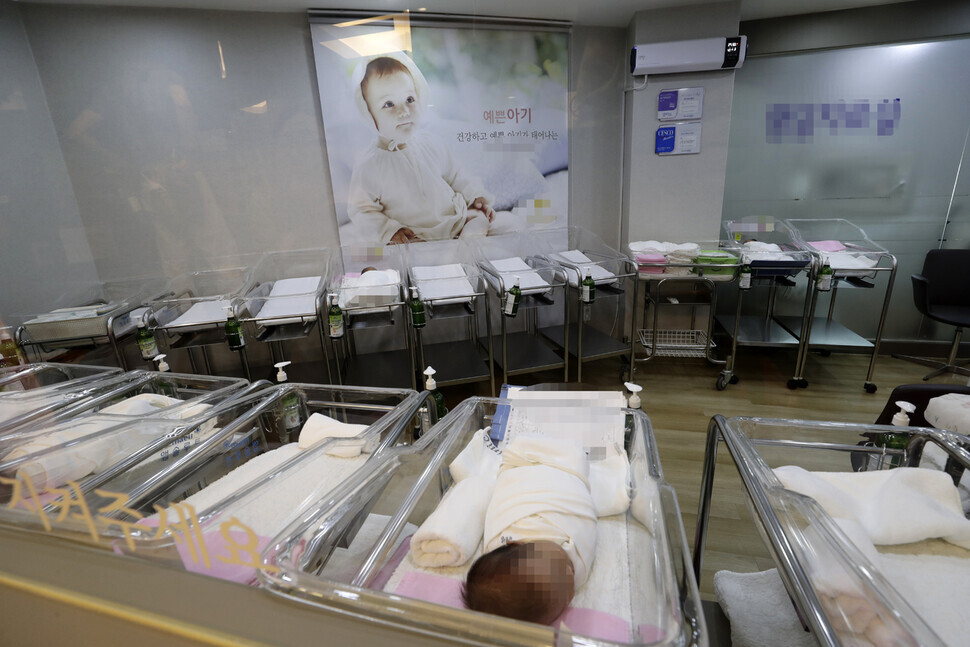On February 28, data from the Korean Statistical Office showed that the total fertility rate, which is the average number of children a woman is expected to have in her lifetime in South Korea, fell to an all-time low of 0.65 between October and December 2023, down 0.05 from the same period last year. The total fertility rate of 0.65 is reportedly the lowest ever recorded quarterly and is well below the replacement level of 2.1 needed to maintain a stable population. This figure has once again sounded an alarm about the demographic crisis in South Korea. According to statistics, the country's fertility rate has continuously declined in recent years. South Korea is the only country among the member states of the Organization for Economic Co-operation and Development (OECD) with a total fertility rate below 1 as of 2021. The ongoing decline in the fertility rate has resulted in many serious consequences, the most visible of which is that schools in South Korea face declining enrollment from a lack of new students. Foreign media outlets have dubbed Korea's low fertility rate a "national crisis."
 |
| ▲ A nurse at a postpartum care center holds a newborn baby in Yanggu County, Gangwon Province. (Photo from Yonhap) |
Moderator: Welcome to today's debate on South Korea's low fertility rate crisis. This is a complex issue with a multitude of contributing factors. Let’s hear from both of our reporters today about different reasons why young people in South Korea choose not to get married and have children.
Reporter Jeong: Currently, Korea is recording the lowest birth rate due to limitations in our social systems concerning marriage and childcare. Before explaining the reason for the decline in birth rates as a limitation of the social system, childbearing must be defined as a human desire. With that in mind, two environmental factors are causing people to avoid giving birth in Korea. First, high housing prices and stagnant wages are why young people do not enjoy stable living conditions. According to a survey by Korea Research, about 55 percent of people said that marriage costs are increasing, and 49 percent of people are concerned about having children, making marriage difficult. Moreover, the marriage information company ‘Gayeon’ found that an average Korean marriage cost about 300 million won, and the average cost of childcare, per child, was also found to be about 350 million won by the Weiwa Population Research Institute in Beijing. These costs have meant that people need to plan more for marriage and childrearing. Second, the government's support policy focuses only on cash. Although it may seem like the best solution to the first issue, it only postpones the problems caused by childcare and does not fundamentally guarantee economic stability. To continue a stable life after raising children, parenting and a career must go hand in hand. However, according to The Embrain Public, 45.2 percent are unable to use childcare leave. In addition, only about 6 percent of office workers take advantage of the 'reduced working hours offered during pregnancy,’ and the ‘reduced working hours system during childrearing.’ Eventually, because childcare also requires a lot of time and labor, more difficulties must be considered when choosing to start a family. Therefore, as marriage is a choice, social systems and environments that lower the entry barriers to childbearing must be created for an environment in which people can compare whether to marry or not.
Reporter Hong: South Korea's birth rate is declining more rapidly than in any other country. According to a 2018 online survey conducted by the Ministry of Health and Welfare on the issue of low birth rates, the top reason cited by respondents for having negative opinions about marriage was "because marriage culture is not gender-equal" (33.2 percent). Particularly among young adults aged 19 to 29, this figure was even higher at 40.6 percent. This indicates that the burden of societal and cultural issues, such as marriage and family systems, outweighs the cost of marriage in terms of factors like housing and employment. The changing social environment in South Korea, which has contributed to low birth rates, can be summarized by three main factors. First, increasing career aspirations and higher levels of educational attainment among women lead to prioritizing professional goals over marriage and child-rearing. Despite progress, instances of women facing disadvantages in the job market due to pregnancy persist. As a result, educated women often tend to avoid pregnancy and childcare in pursuit of professional success. Second, the growing sense of individualism and materialism in society has resulted in a decreased desire for large families. In recent years, with the increase in single-person households, there has been a growing number of people who argue that living alone does not necessarily lead to loneliness and offers convenience and comfort. Third, negative attitudes toward marriage stemming from high divorce rates and gender inequality discourage young adults from committing to long-term partnerships.
 |
| ▲ A single infant can be seen in the nursery at an OBGYN office in Seoul Seongbuk District. (Photo from The Hankyoreh) |
Reporter Jeong wants to get married and raise children, so he is concerned about a social atmosphere in which marriage and childbearing are viewed as difficult, affecting the lives of the children he hopes to raise in the future. There is a great concern that children will face difficulties after they grow up due to a lack of appropriate social systems. Moreover, his friends have indifferent or negative views about marriage and childbearing. Those negative thoughts evoke empathy for friends, and the problems of the social system that each person experiences seem to guarantee a negative outcome. This atmosphere arouses antipathy toward marriage and childrearing even before people have a chance to actually experience it. Therefore, reporter Jeong said we need to create a society where getting married and raising children results in as much happiness as not getting married and raising children. On the other hand, recently, reporter Hong had a conversation with friends about concerns and anxieties surrounding the low birth rate issue. While each person had slightly different perspectives and areas of concern, most of them viewed the low birth rate problem as directly impacting their future. One friend shared an experience of their elementary school's enrollment shrinking by more than half, leading to the possibility of closure. This anecdote highlighted concerns about the rapid population decline. Additionally, many friends connected the population issue to the decline in national strength and worsening economic conditions in South Korea. Furthermore, there were concerns among friends about the prospect of increased taxes in the future. Overall, young Koreans are expressing various worries about the low birth rate problem, but with no clear solution in sight, these concerns continue to grow.
In conclusion, today's debate has shed light on the complex and multifaceted nature of South Korea's low fertility crisis. We have heard compelling arguments that both economic pressures and social transformations are significant contributing factors. A single solution would not suffice. We need a multifaceted approach that tackles both economic burdens and societal challenges. The government must consider initiatives like increased financial support for childcare and maternity leave, promote flexible work arrangements for working parents, and address the issue of stagnant wages. Additionally, fostering gender equality within the workplace and home will be crucial in creating a more supportive environment for families. However, the conversation does not end here. We must continue this dialogue and involve the voices of young Koreans, who will be most impacted by these decisions. By acknowledging their concerns about affordability, work-life balance, and changing social values, we can craft solutions that encourage them to consider having children and therefore ensure a brighter future for Korea.
Dinh Phuong Thao, 정영훈, 홍채연 dankookherald@gmail.com

 Vote for the Campus Brand Naming!
Vote for the Campus Brand Naming!

![[Campus Magnifier] Let's Surf the Library!](/news/thumbnail/202404/12496_1765_4143_v150.jpg)




